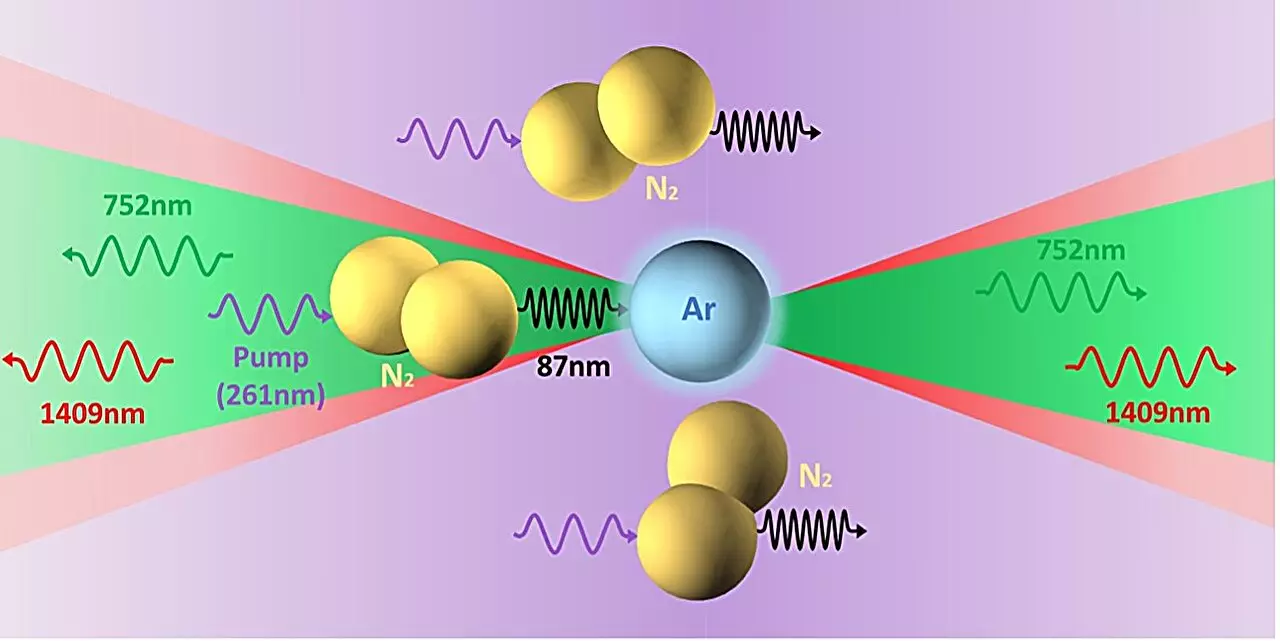Lasers have long been an essential part of modern technology, utilized in various fields ranging from telecommunications to medicine. Traditionally, the design and function of lasers hinge upon optical cavities, in which pairs of mirrors reflect light back and forth, amplifying it through a repeated process. However, a novel approach has emerged in recent research efforts—cavity-free lasing in atmospheric air. Recent discoveries by researchers from the University of California Los Angeles (UCLA) and the Max Born Institute have pushed the boundaries of laser applications, promising exciting new capabilities for photonic technology.
Cavity-free lasing represents a significant departure from typical laser operation. In this new paradigm, researchers have uncovered a mechanism that allows for the generation of laser-like light in open air, free from the confines of traditional optical cavities. The study, recently published in the journal Physical Review Letters, reveals that this phenomenon is underpinned by the energy transfer mechanisms between nitrogen (N2) and argon (Ar) molecules. Co-author Chan Joshi noted an intriguing deviation in the ionization rates of argon when subjected to high-field conditions, proposing that the interaction of nitrogen and argon facilitated this unexpected behavior.
The implications of this new finding are substantial. The research team observed 3-photon resonant absorption in argon, which subsequently resulted in cascaded superfluorescence—a form of coherent light emission that exhibits characteristics akin to laser light. This cascade effect not only amplifies the light but also creates a unique scenario in which two distinct wavelengths can be emitted in a bidirectional manner.
The ability to achieve bidirectional and wavelength-tunable emissions in atmospheric air marks a remarkable advancement in laser technology. Lead author Zan Nie highlighted a particularly surprising finding: by adjusting the argon content in a nitrogen-rich mixture, the wavelengths of the emitted light shifted, revealing a new mechanism of lasing based on the interplay between atmospheric gases. This discovery not only enhances our understanding of light generation but also opens pathways to innovative applications in fields such as remote sensing.
The research illustrates the importance of the nitrogen-argon interaction, which has emerged as a critical factor in the novel lasing mechanism. This bi-directional cascading process allows laser light to be emitted towards the environment while simultaneously enabling the environment to respond with its own laser-like emissions. The proposed mechanism may eventually lead to backward lasing, a target of considerable interest in the physics community for its potential applications.
Diving deeper into the technical aspects, the research also emphasized the significance of N2 molecules that transition into electronically excited states. These states involve nonlinear 3-photon absorption at frequency shifts that elegantly align with those of argon, creating the illustrative conditions for producing superfluorescent emissions. The exploration of this quantum interaction reveals layers of complexity that could influence various applications of this new lasing technology.
The authors propose a theoretical model that unmasks the intricacies of superfluorescence and elaborates on the interplay of the different molecular states involved. As co-author Misha Ivanov notes, achieving efficient, cavity-free lasing capable of bidirectional output has been a formidable challenge in the field. The prospect of illuminating the atmosphere to generate feedback inherently expands the potential for remote sensing applications, making it possible to develop new technologies that can monitor environmental changes or locate materials from significant distances.
Looking ahead, the researchers have outlined a roadmap for further inquiry. Understanding the detailed physics, including quantum beating and oscillation of charge density in argon, will be crucial as they refine their models. This future research aims to uncover hidden quantum states and vibrational-rotational levels in nitrogen which could be pivotal in enhancing the efficiency and effectiveness of the lasing mechanism.
The study epitomizes a paradigm shift in our approach to lasing in open air, opening avenues for breakthroughs not only in scientific understanding but also practical applications. The emergence of cavity-free lasing challenges conventional wisdom and offers a tantalizing glimpse into the future of atmospheric photonics. As researchers continue to investigate this phenomenon, the realization of more advanced remote sensing technologies and enhanced laser systems becomes increasingly plausible. The implications of this research could transform not only how we understand light but also how we harness its potential in our rapidly evolving technological landscape.

